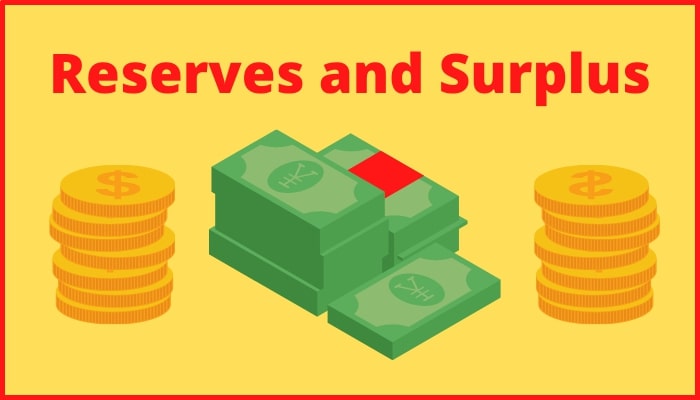When You start investing in the stock market, it is necessary for you to read the balance sheet of any company as it plays a critical role in informing you about the company. However, there are some terms in the balance sheet which are unknown for many people like reserves and surplus.
Let’s understand them with an example and their types as well.
Table of Contents
What is Reserves and Surplus?
Reserves and surplus are the total amount of maintained earnings reported as a component of Shareholders Equity and set aside by the firm for specified objectives such as purchasing fixed assets, paying legal settlements, repaying debts, or paying dividends, and some others.
Different types of Reserves and Surplus in Balance Sheet
There are majorly 4 types of Reserves & Surplus you will find in a balance sheet which are:

-
General Reserve
A revenue reserve is another name for a general reserve. Revenue reserves are the funds set aside by a company from its earnings for the objective of future use. It is purely a corporation’s retained earnings, which are set aside from profits to meet specific or unclear responsibilities.
-
Capital Reserve
A capital reserve is a portion of a company’s profit that is set aside for a particular reason, such as financing long-term initiatives or deferring capital expenditure. This reserve is made up of any capital profit obtained by a firm from sources other than the organisation ‘s primary business.
-
Capital Redemption Reserve
On the redemption of preference stocks or throughout the buyback of own stocks to decrease the share capital, the Capital Redemption Reserve is established from the undistributed earnings in the general reserve or the profit and loss account.
-
Dividend Reserve
The money maintained in a separate account for securing that a similar amount of dividend is announced annually is known as the dividend reserve.
Example of Reserves and Surplus
Consider the case of Britannia, a FMCG company. Throughout the financial year 2020–21, the firm earned INR 3,038 Cr. through its usual operation of business. The management team has agreed to set aside 7% of earnings produced over the financial year for future obligations for the General Reserve.
The firm has distributed stocks for which they have secured a INR 350 cr. premium. Over the same time period, the amount in capital redemption reserve and dividend reserve was INR 140 cr. and INR 190 cr. separately.
Total Reserve and Surplus
The overall amount of reserves and surplus will be equal to the total of the general reserve, stock premium account, capital redemption reserve, and dividend reserve. The Overall Reserves and Surplus = 212.66 (3,038 * 7%) + 350 + 140 + 190 = INR 892.66 Cr.

Benefits of Reserve and Surplus
These are the main benefits :
-
Internal financing
Reserves are regarded as the most important source of internal financing. When the firm requires funds for its commercial operations or to satisfy its obligations, the first and most convenient source of funds is the company’s generated general reserves.
-
Working Capital Requirements
The firm can sustain its working capital needs with the support of reserves since reserves can be used to boost working capital when the company’s working capital is insufficient.
-
Liabilities
Another major benefit of having reserves and surplus is that it allows organisations to withstand future losses by using time of loss reserves to pay off present liabilities.
-
Dividend Distribution
The majority of the money needed for dividend distribution comes from reserves. It assists in preserving dividend distribution rate similarity by offering the amount necessary to keep the dividend rate uniformity when there is a deficit of funds accessible for distribution.
Drawbacks of Reserve and Surplus
These are the main Drawbacks:
-
At the time of losses
If a firm has losses and those losses are adjusted/set-off against the firm’s reserves, the accounts will be manipulated in some way since the true picture of the firm’s profitability will not be presented to the financial statement readers.
-
Misuse of Funds
The general reserves, which make up the majority of reserves and surplus, are not set aside for any particular reason. However, because of the widespread use, there is a risk that funds collected in general reserves will be misappropriated by the management team, and that the money will not be used appropriately for business growth.
-
Extra Reserves
The creation of extra reserves may result in a decrease in dividend payouts to investors.
Key Takeaways

- The reserves and surplus established by the firm are the reserves that the company can use for whatever reason they are produced for, depending on the kind or type of reserve and surplus. In most cases, these reserves are established by the corporation to cover any future emergencies.
- Dividend distribution, meeting future liabilities, recovering losses, handling working capital needs, meeting finances required for business expansion, and so on are all examples of how reserves and excess are used.
- To offset the loss in sales and slow-paying consumers, the corporation must keep cash reserves on hand at times. In general, the amount of cash reserves a firm keeps is defined by the nature of business it does.
Conclusion
To deal with declining income and slow-paying consumers, cash reserves and surpluses are often maintained. However, Please keep an eye on this kind of company as this can be risky.
This is all from our side regardingreserves and surplus are which form of financing. Let us know your views in the comment section.
Other Interesting blogs related:
Difference between Commercial Paper and Certificate of Deposit
Difference Between Equity Shares and Preference Shares
Difference between Nifty and Sensex
FAQ About Reserve and surplus
Reserve and surplus are shown under
Reserve and surplus are shown under liability in balance sheet.
Reserves and surplus meaning in Hindi
रिजर्व और सरप्लस शेयरहोल्डर्स इक्विटी के एक घटक के रूप में रिपोर्ट की गई कमाई की कुल राशि है और फर्म द्वारा निर्दिष्ट उद्देश्यों के लिए अलग रखी जाती है जैसे कि अचल संपत्ति खरीदना, कानूनी निपटान का भुगतान करना, ऋण चुकाना, या लाभांश का भुगतान करना, और कुछ अन्य।
Types of reserves and Surplus
Major Reserves and surplus are General Reserve, Capital Reserve, Capital Redemption Reserve and Dividend Reserve.
Reserves and surplus does not include?
Reserves and surplus does not include sinking fund and provident fund.
Reserves and Surplus are which form of financing?
Reserves and Surplus are which form of Internal Financing.

